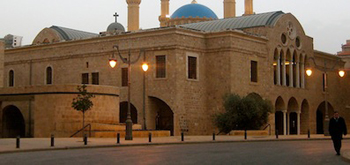Lebanon, March 19, 2012

Close links have developed between the Law School of Beirut and the Church. The bishop of Beirut Eustathius (Eustache), by decree of the Byzantine Emperor Theodosius II in the year 449 or 450, managed to give the city of Beirut, the title of “Metropolis”, a privilege that until then belonged the city of Tyre which was the capital of Phoenicia.
Efstathius also built in Beirut a large cathedral, the church of the Resurrection (Anastasis Church), which bordered on the “auditoria”, the classrooms of the Law School of Beirut where Christian students worshiped in the afternoon after their lessons.
The Anastasis church was destroyed in 551 AD by a massive earthquake that devastated Beirut.
After the earthquake of 551, the Anastasis cathedral was build again around the twelfth century. In 1759 the cathedral was again shaken by another earthquake. It was then destroyed again to be rebuilt with a single altar, this time dedicated to Saint George. Ultimately the design turned out to be untenable; the cathedral collapsed again three years later after it was rebuilt. Finally in 1772 it was erected once more with three new altars as it still stands today.
During the Lebanese civil war, the Cathedral suffered many attacks of theft and vandalism, as well as effects of nature’s impact in a region considered a war zone and confrontation line. In 1998, the restoration multi-phase project started on the 15th of December, 2003, when the Cathedral once again opened its doors to the faithful.
